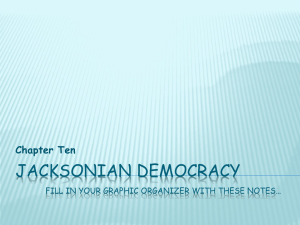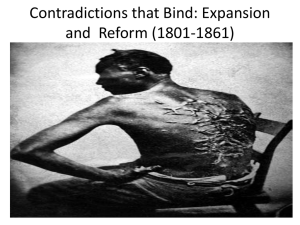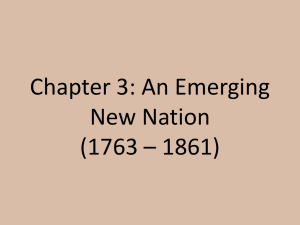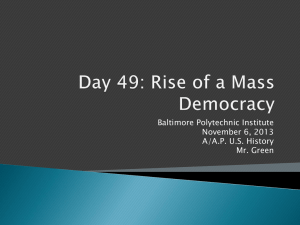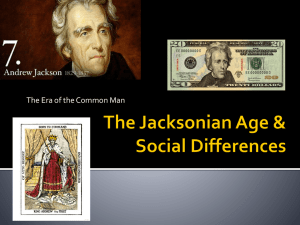Unit 5 Powerpoint (Notes Version)
advertisement
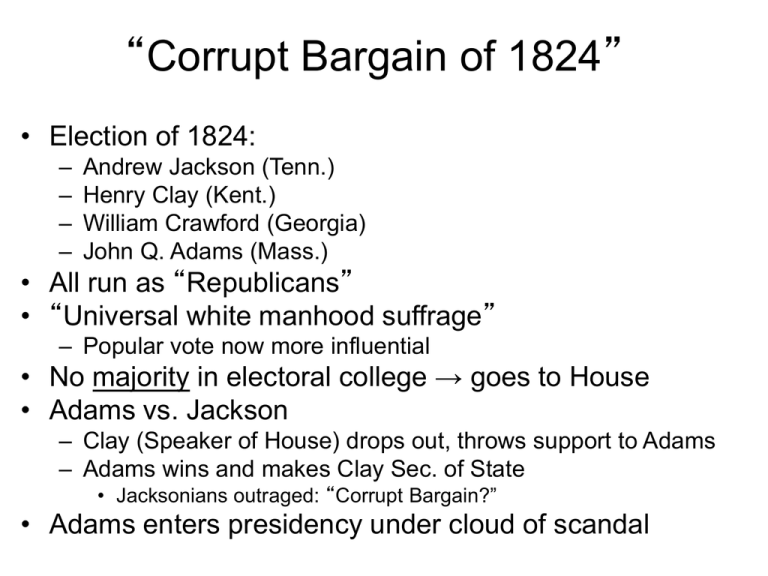
“Corrupt Bargain of 1824” • Election of 1824: – – – – Andrew Jackson (Tenn.) Henry Clay (Kent.) William Crawford (Georgia) John Q. Adams (Mass.) • All run as “Republicans” • “Universal white manhood suffrage” – Popular vote now more influential • No majority in electoral college → goes to House • Adams vs. Jackson – Clay (Speaker of House) drops out, throws support to Adams – Adams wins and makes Clay Sec. of State • Jacksonians outraged: “Corrupt Bargain?” • Adams enters presidency under cloud of scandal President John Quincy Adams • Smart, capable, respected, but… • Seen as distant from people • Alienated… – His own party • Does not engage in cronyism – The South • built roads, canals, education, pro-Indians – The West • slowed western land speculation, pro-Indians Election of 1828… • New political party created: “Democratic Party” – Made up of Jacksonians, Southerners, Westerners • Jackson extremely popular with common people • Mudslinging highlights campaigning: – Jackson supporters attack “dishonest” Adams – Adams campaigners attack Jackson and wife Rachel’s character President Andrew “Old Hickory” Jackson • Westerner, loyal, tough, passionate, halfeducated – Rags to riches story • Represented the common man – “Era of the Common Man” • Instituted the “Spoils System” – Rewards political party workers with gov’t jobs • (Jackson’s loyal character) – Criticized heavily • “To the victor belong the spoils.” – Not overly utilized – Samuel Stwartwout scandal “Tariff of Abominations” • Import tax causing sectionalism: – Northeast in favor of high tariff • Protects manufacturers – South and West hate tariff • Drove up costs • Jackson’s plan to reduce tax backfires • Tariff of 1828 passed… – Tariff raised to extreme 45% – South and West outraged • SC fears of abolition increasing… – Britain moving towards abolitionism – Denmark Vesey leads unsuccessful slave rebellion in Charleston Nullification Crisis • John C. Calhoun promotes SC’s right to nullify the tariff – Based off “Virginia and Kentucky Resolutions” – Directly challenges power of federal gov’t • Tariff of 1832 passed to scale back tax • SC still votes to nullify federal tariff – Threatened secession if not respected – Jackson readies army to invade SC • Henry Clay organized compromise: – Nullification repealed – Tariff gradually lowered – Congress passes “Force Bill” – reserves right of president to use force to collect tariff • Significance? – SC abides by tariff, but successfully challenged federal gov’t Jackson’s Native American Policy • Westward expansion causing problems with Indians • Many felt Indians and whites couldn’t coexist peacefully – Assimilation attempts had failed • Indian Removal Act – Indians forcibly relocated to western territories (Oklahoma) • “Trail of Tears” – Cherokees relocated from GA to OK (1/3 of 15,000 die en route) • Indian resistance fails – Created Bureau of Indian Affairs New Election Trends • Jackson easily defeats Clay • America becoming more democratic… – New parties emerge: • “Whig Party” and “Anti-Masonic Party” • Both made up of various factions – hated Jackson – National nominating conventions • People of political party directly nominate candidates – “Party platforms” printed and distributed – Laid out position on the issues Jackson vs. Bank of the U.S. • Jackson distrusted Bank of U.S. – Tool for rich to get richer • Bank minted “hard” coin money (economic stability) – Poor get poorer • Poor wanted “soft” paper money (allows for inflation • Nicholas Biddle (B.U.S. President) – Coined hard money, cracked down on western “wildcat” banks • Jackson vetoes Clay and Webster’s bill to recharter B.U.S. – Lose-lose situation for Jackson • “The Bank…is trying to kill me, but I will kill it.” Jackson vs. Bank of the U.S. • Jackson and Biddle battle in “Bank War” – Chaos ensues in banking system • Bank foreclosures rampant • Hurts “the common man” – Jackson still supported (West vs. East = sectionalism) • 1836 – Bank of the U.S. closes – “Divorce Bill” passed by Martin Van Buren • Gov’t divorced from banking • Independent treasury set up – Gov’t money kept in vaults, not banks • Birth of modern Federal Reserve System Texas • Vast farming land – cotton • 1823 – Stephen Austin leads 300 families in to settle • Mexican President – Santa Anna allowed them under conditions: – 1. Must become Mexican citizens – 2. Must become Catholic – 3. No slavery allowed • Texans protest Mexico freeing it’s slaves • Declare independence in 1836 – “Lone Star Republic” Texas • 1836 – Battle of the Alamo – Mexicans crush outnumbered Texans • Tex pres. Houston wins Battle of San Jacinto – Santa Anna forced to surrender • Texas independent – Wants to join U.S. – Slavery debate kills movement for annexation President Van Buren • Jackson’s popularity leads to his VP, Martin Van Buren being elected – Whig party still new and unorganized – Van Buren not as loved by people – Took problems caused by Jackson • Issues for MVB: – Panic of 1837 • Over-speculation, failing crops, and Jackson’s: – Bank War created chaos – “specie circular” debt system fails – Neutrality between Canada & England uprising – Annexation of Texas issue • North angered at possible slave state • Who gains strength from these issues? Whigs Gaining Strength… Two-Party System Returns • • • • • • Democrats “Common man” States’ rights Lower classes Farmers South, West Small towns • • • • • • Whigs Strong, central gov’t National bank, tariffs, public education Wealthy, educated Industry East Cities Election of 1840 • Whig Party gains power • W.H. Harrison and John Tyler nominated • Birth of modern campaigns – Log Cabin image of Harrison – Hard Cider, slogans, and songs: • “Tippecanoe and Tyler Too” Mid 1800s America • America moving west – “land butchery” • Industrial Revolution – Cotton gin • Gold discovered in North. California (1849) • Irish and German immigration • Sparks rise of “Know-Nothing Party” – Nativist political party • Transportation improves (highways steamboats) • Erie Canal (booms in NYC, Midwest cities) • Education and reform Cotton • Cotton gin invented by Eli Whitney in 1793 – Demand for cotton • Leads to “land butchery” – westward expansion • more slavery • ½ of world’s cotton grown in South – South believes their economic importance to the world would give them support in case of war with North “Cottonocracy” • “Antebellum” (pre-Civil War South) • Oligarchy – government by a small number of elite – About 1,700 families had large plantations with more than 100 slaves – Had the most political power • Social ranking system: – 1. elite, large slave-owners – 2. small farmers – owned a few slaves – 3. poor, non-slave owning whites (3/4 of white population) • Despised wealthy slave owners • Still pro-slavery, very racist Plantation Slavery • Slave importation banned in 1808 – Not regulated or enforced – Slave population self-sufficient through childbirth • Slaves = investment – Protected from dangerous jobs • Deep South – SC, Louisiana – Most strict, tough areas for slaves • Slave revolts (Denmark Vesey, Nat Turner) caused tighter security and worse laws for blacks Abolitionist Movements • “Uncle Tom’s Cabin” by Harriet Beecher Stowe – Emotional and chilling portrayal of slavery – HUGE impact on debate of slavery • Frederick Douglass – Escaped slave • William Lloyd Garrison – Extremist-abolitionist – Seen as disruptive to unity, Northern economy South’s Defense • “Bible supported slavery” • Slave owners convert their slaves to Christianity • Whites and “happy darkies” get along • Slaves and slave-owners like family • Slaves lived better lives than Northern “wage slaves” Whig Party Loses Leader, Power • William Henry Harrison dies after a month in office – VP John Tyler is new president – Tyler not very “Whig-minded” – Vetoes Whig legislation – kicked out of party – Tyler deals with numerous foreign affairs • Canadian attack on American ship • Borders of Maine (U.S. vs. Britain) • British giving escaped slaves asylum • 1844 – James K. Polk (Democrat)runs for president – Platform of expansion and “Manifest Destiny” Polk’s Presidency • Polk very successful and efficient • 4 part plan: – – – – Lower the tariff Restore independent treasury Clear up the Oregon border issue Get California • Accomplished all in 4 years • Issue with Texas – Still independent – Texas becoming friendly with European countries – Dilemma for America • Slavery issue, economic factors, Monroe doctrine – Polk invites Texas to join the U.S. in 1845 Mexican-American War (1846-1848) • Polk wants California (Mexican territory) – Offers to buy first, uses force when refused – “Baited” Mexico into a war – Santa Anna cleverly returns to lead Mexican Army • U.S. dominates Mexico in 3 phases: – Occupy California – Secure Texas – Conquer Mexico City • Treaty of Guadalupe Hidalgo • Mexican Cession – forced to give up present day CA, NV, AZ, NM, CO, UT • Gadsden Purchase made in 1854 – Needed land for railroad route President Zachary Taylor • Gen. Zachary Taylor wins presidency under Whig Party in 1848 • Challenged by “Free Soil Party” • People moving west (new land, gold in CA) – Issue of slavery – slave or free states? • Huge debate between North and South – Clay, Webster, Calhoun – Slowly working towards compromise – Taylor (anti-slavery) threatens to veto if North makes any concessions – Taylor dies, compromising VP Millard Fillmore takes over… Compromise of 1850 • North gets: – California is a free state – balance tipped to free side – Texas gives up disputed New Mexico land – Slave trade now illegal in D.C. (symbolic significance only) • South gets: – Popular sovereignty in new Mexican Cession lands • New states vote whether to be a free state or slave state – Texas paid $10 million for loss of land given to New Mexico – Fugitive Slave Law: runaway slaves given no “due process”, money paid for catching and returning of slave, Northern officials forced to catch slaves • North passes laws to avoid forced capture • Leads to further dissention between North and South Outbreaks of Violence • President Franklin Pierce wins election in 1852 – Democratic party, safe choice – no enemies • Violent steps taken towards disunity: • Kansas-Nebraska Act – Transcontinental railroad compromise • Kansas open to popular sovereignty • Becomes battleground between North and South – Extreme and violent abolitionist: John Brown • murderer or martyr? – Kansas “wins” vote to become slave state (scandal) • 1856 – Brooks-Sumner Incident – Southerner attacks Northerner in Congress with a cane President James Buchanan • President James Buchanan wins election in 1856 – Democratic – Ran against John Fremont (Republican) – Northerner, but sympathetic towards South • Panic of 1857 – Caused by over-speculation, inflation caused by California gold, and overproduction of grain Dred Scott Case (1857) • Slave moved by master from South to North, then back to South – Tried to sue for freedom → lost case – Decision Stated slaves not citizens → cannot use legal process – Also stated Congress cannot outlaw slavery • Infuriates North • South now had advantage politically (president, Supreme Court, Constitution) • North has powerless majority Congress Rise of Lincoln 1858 Illinois Senate Race: Abe Lincoln (Rep) vs. Stephen A. Douglas (Dem) •“The Great Debates” •Douglas wins election, loses his heavy support from South after “Freeport Doctrine” – Stated people hold power to vote down slavery, despite the Supreme Court •Lincoln loses, but becomes national figure Election of 1860 • Democrats split: – North wants Stephen A. Douglas to run • Popular sovereignty position – South wants John C. Breckinridge • Pro-slavery position • Republicans select Abe Lincoln – Campaign successfully unites many Northern factions: • • • • • Free-Soilers (will stop slavery’s expansion) Manufactures (will raise the import tariff) Immigrants (will secure better rights) Westerners (will build a NW railroad) Farmers (will establish homesteading) – System of federal land grants Election of 1860 • Lincoln not an abolitionist, but was a FreeSoiler → hated by the south • SC threatens to secede if Lincoln wins election • Southern votes split between Douglas and Breckenridge • Lincoln wins comfortably in November, 1860 – Scheduled to take office in March 1861 The South Secedes • SC secedes in Dec. 1860 – Soon followed by “Deep South” • Alabama, Mississippi, Florida, Georgia, Louisiana, Texas – Feb 1861 – Southern states form “Confederate States of America” • Elect Jefferson Davis as President of C.S.A. – President Buchanan did almost nothing to stop the secession – One final compromise offered – Crittendon Compromise (extend Missouri Compromise line – north = free, south = slave) – Lincoln takes over, crushes compromise • “Honest Abe” took free-soil pledge, wouldn’t break it Why the South Seceded: • Institution of slavery threatened by North – Would kill Southern economy if outlawed • Believed starting own nation allows own development – Economy, industry, banking, shipping, etc • Compared their secession to independence of American colonies in 1776 – U.S. breaks from England, South breaks from North • South didn’t think North would try to stop their secession • If war did break out, Europe would support South due to its economic value
